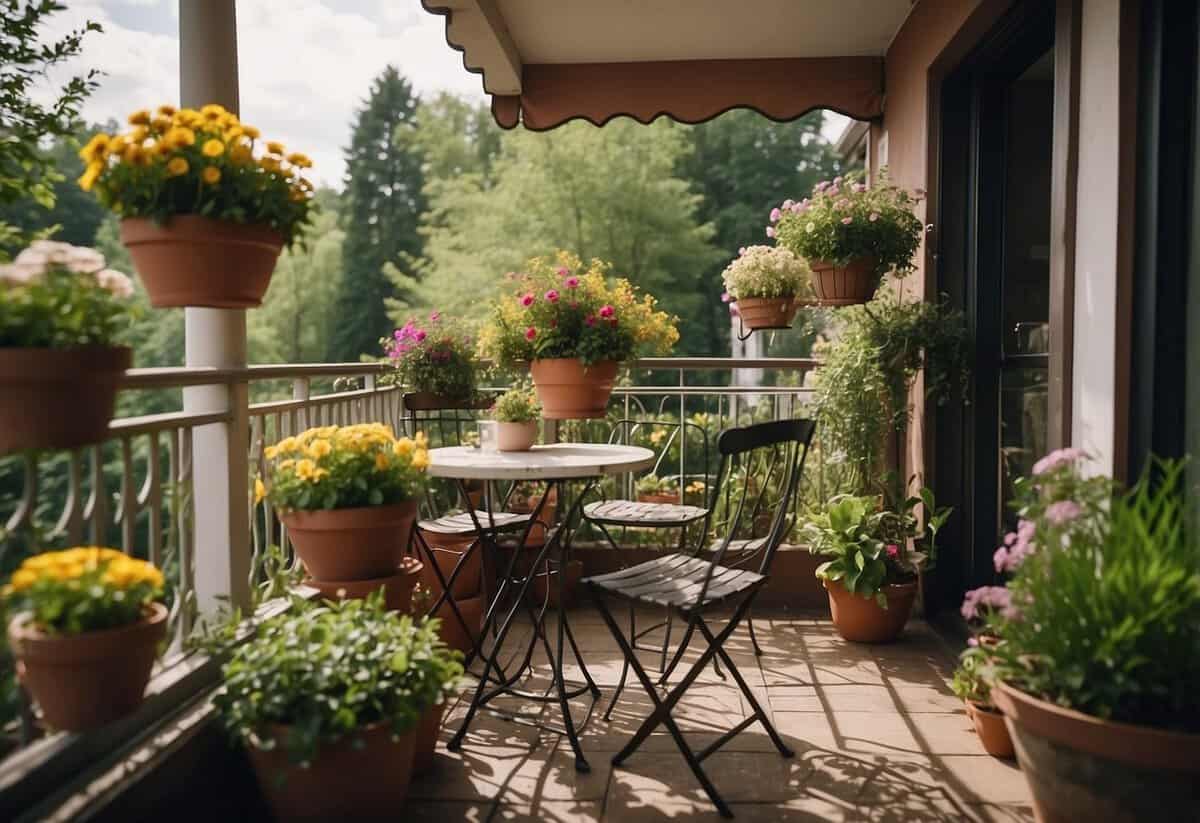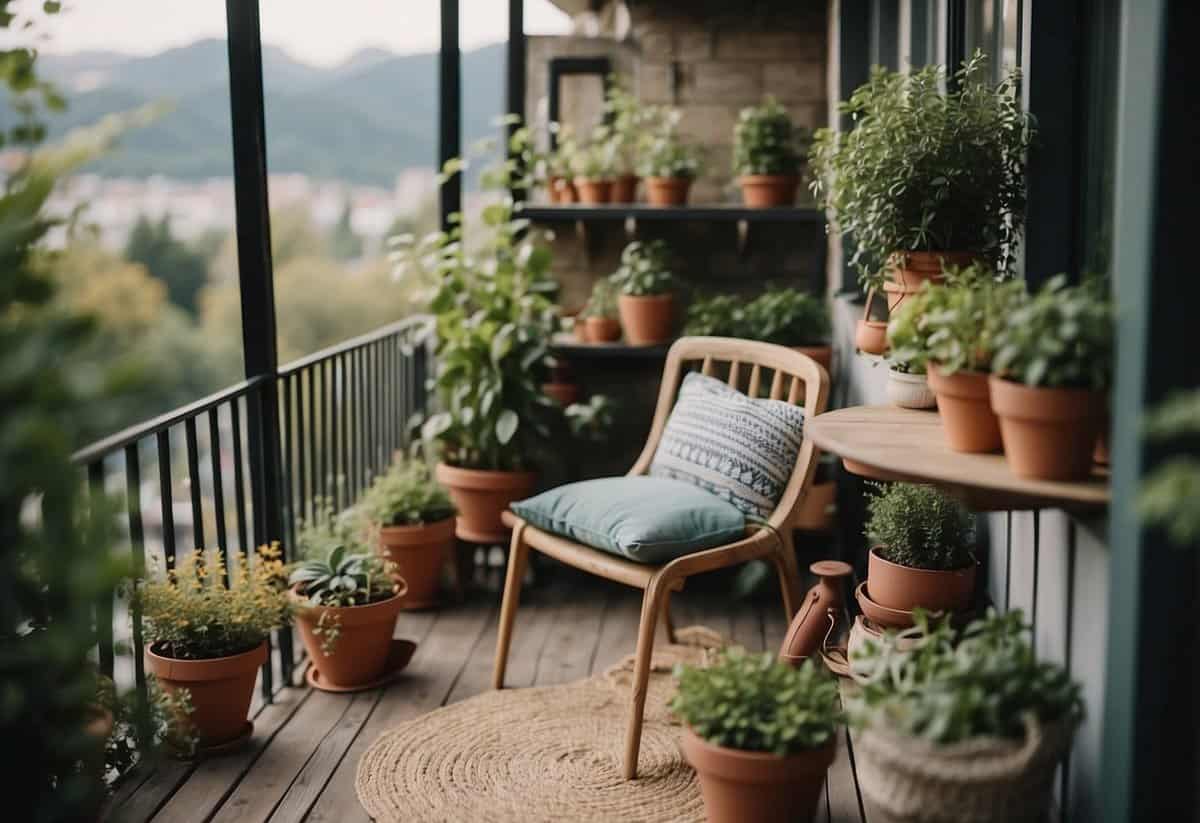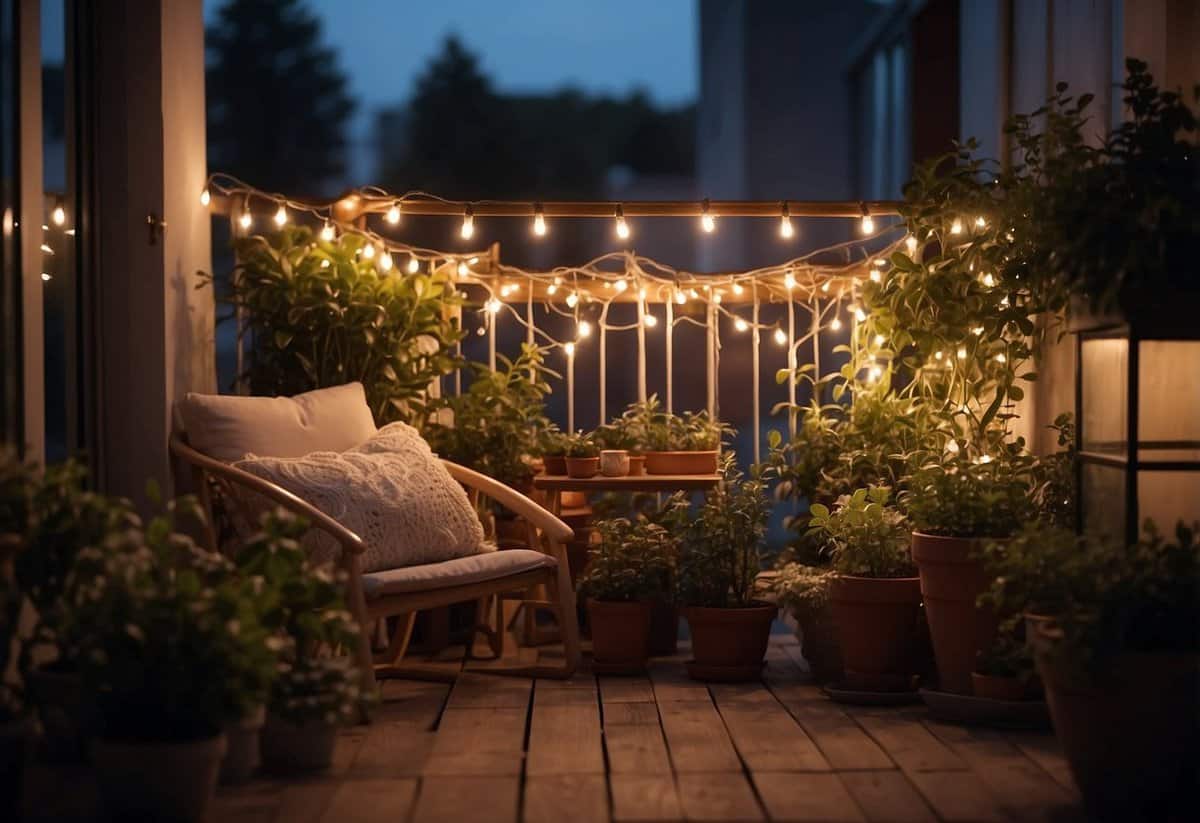Balcony Garden Tips: Create a Green Oasis in Your Home
Creating a balcony garden can be a rewarding way to bring some greenery into your life, especially if you don’t have a yard. It’s a versatile space that can be designed to fit your preferences and available space. Whether you want to grow flowers, herbs, or even vegetables, there are plenty of options to explore.

What are the key tips to successfully start and maintain a balcony garden? This article will share practical advice and strategies to help you make the most of your small outdoor space. From choosing the right plants to keeping your garden thriving, you’ll find everything you need to turn your balcony into a green oasis.
1) Choose Compact Furniture

When setting up your balcony garden, picking the right furniture is key. Lightweight, folding, and stackable designs work best because they save space.
Consider corner-hugging sofas or small cocoon chairs for comfort. Look for pieces that serve multiple purposes, like benches with storage. This way, you keep your balcony tidy and functional.
Compact furniture ensures you have more room for plants and movement. It helps you enjoy your green space without feeling cramped. For more ideas on choosing the right furniture, visit this guide.
2) Utilize Vertical Space

Using vertical space in your balcony garden is a great way to grow more plants. Install trellises and hanging baskets to make the most of your area.
Wall planters can also help you use every inch of available space. They allow you to plant herbs, flowers, and small vegetables without crowding your floor.
Try adding vertical shelves or stacking pots. This can keep your balcony organized and neat. It’s a simple way to expand your gardening options in a small space.
3) Opt for Light-Colored Plants

Light-colored plants can brighten up your balcony garden. They reflect sunlight, which can help other plants grow better.
Plants with pale flowers or leaves also give a fresh look to the space. Colors like white, light pink, or pale yellow are great choices.
Try growing white petunias, pale pink geraniums, or yellow pansies. These plants can thrive even in smaller spaces like balconies.
4) Incorporate Hanging Baskets

Hanging baskets are a fantastic way to add greenery to your balcony without taking up floor space. They’re perfect for bringing color and life to small areas.
Choose plants with vibrant colors and interesting textures. You can create a classic look with two similar shades or mix colors for a lively display. Consider plants like begonias, ferns, and succulents for your hanging baskets.
Using hanging planters can also give your balcony a unique look. Try using wired hooks on the railing to hang pots outside, saving even more space.
5) Install Compact Seating

Creating a cozy spot to sit can make your balcony garden more enjoyable. Look for foldable or stackable chairs that save space. You can tuck them away when not in use.
Consider a small bench with storage underneath. It provides seating and a place to store gardening tools.
Adding some cushions can make your seating area inviting. Choose weather-resistant fabrics to ensure they last.
6) Use Multi-Functional Furniture

Choosing multi-functional furniture can help save space on your balcony. Pieces like storage benches or foldable tables offer both functionality and style.
Think about using convertible sofas, storage benches, and vertical gardens to maximize your space. These items provide extra seating or storage without taking up too much room.
Remember, selecting furniture that serves multiple purposes can make your balcony more efficient and enjoyable!
7) Add Potted Herbs

Growing herbs in pots on your balcony is a great way to enjoy fresh flavors. Choose herbs that are easy to grow like basil, mint, and rosemary.
Make sure your pots have good drainage to prevent waterlogging. You can use pots of different sizes, but remember, some herbs like dill and lavender need larger containers.
Place the potted herbs where they can get at least six hours of sunlight daily. If your balcony is shady, opt for shade-tolerant herbs like mint and chives, which can still grow well without full sun.
8) Create a Small Water Feature

Adding a small water feature to your balcony garden can bring a soothing ambiance. You don’t need much space or money to do it.
You can use a large water-tight container and a simple fountain kit. DIY water features can also include plants like iris, lily, and hyacinth.
A mini garden pond only takes an hour to set up. Just find a sunny spot with at least four hours of light.
9) Incorporate Trellises for Vines

Adding trellises to your balcony garden can bring both beauty and function. Many climbing plants thrive better with support, making trellises a great choice.
Consider choosing a trellis design that complements your balcony’s style. Trellises come in materials like wood, metal, and vinyl. Each has its own look and feel.
Some great vine options for balcony trellises include sugar snap peas and scarlet runners, both of which love plenty of sunlight and water. Hummingbirds are especially fond of scarlet runners, adding an extra touch of nature to your space.
If you like a DIY approach, there are many creative trellis ideas you can make yourself. Simple bamboo fencing is an inexpensive and effective option, and you can place it anywhere from a wall to a freestanding structure. This can provide a sturdy framework for your climbing plants.
For a touch of color, try growing honeysuckle on your trellis. Using a small, painted wooden trellis can add visual interest while supporting your vines.
Adding trellises can transform your balcony garden into a lush, green oasis with beautiful, climbing plants.
10) Use String Lights for Ambiance

String lights can transform your balcony garden into a cozy retreat. They are affordable and come in various styles to match your taste.
Hang the lights along your balcony railing or drape them above seating areas. You can also create unique patterns like the maypole design, where all strings originate from a central pole.
For a relaxed vibe, choose soft, yellow-tinted lights. If you want a more vibrant feel, opt for colorful lights. String lights not only illuminate your space but also add a charming touch to your garden.
Choosing the Right Plants

Picking the right plants for your balcony garden involves considering the amount of sunlight your space gets and selecting containers that fit your plants’ needs. The right choices can make your garden thrive.
Considering Light Conditions
When choosing plants, think about how much sun your balcony gets during the day. If your balcony faces south and gets a lot of direct sunlight, consider sun-loving plants like cacti, succulents, and many flowers. These plants thrive with lots of light.
For balconies with partial shade or those facing east or west, choose plants that can tolerate less sun. Herbs like mint, parsley, and cilantro, and leafy greens such as spinach and lettuce, can do well in these conditions.
North-facing balconies, which get the least light, are suitable for shade-loving plants. Consider growing ferns, hostas, or ivy. Arrange your plants to ensure the tallest ones do not shade the smaller ones.
Selecting Suitable Containers
Choosing the right containers is crucial for your plants’ health. Materials like clay, plastic, and ceramic each have their own benefits. Clay pots are breathable and good for plants requiring well-draining soil. Plastic pots retain moisture well and are lightweight. Ceramic pots are durable and stylish but can be heavy.
Make sure your containers have good drainage holes to prevent waterlogging. You can improve drainage by placing small stones at the bottom of the pot.
Size matters too. For deep-rooted plants like tomatoes, choose larger pots. Small herbs and flowers can thrive in smaller pots. Ensure the containers are large enough for the plants to grow without being cramped.
Picking the right container helps mimic the plant’s natural environment and gives them room to thrive.
Optimizing Your Balcony Space

Making the most of your balcony garden involves clever use of vertical space and railings. These strategies can turn even the smallest areas into thriving green spaces.
Creating Vertical Gardens
Vertical gardens are perfect for small balconies. By growing plants upwards, you save floor space and create a lush, green wall. Use stackable planters, hanging pots, or even wall-mounted shelves. These methods let you plant more without cluttering the ground.
Choose plants that grow well in vertical setups. Vines, such as ivy or morning glories, can climb and cover the space beautifully. Herbs like basil and mint are also great options. They don’t need much room, and you can easily reach them for cooking.
Watering can be tricky with vertical gardens. Ensure all levels get enough moisture. You might consider a drip irrigation system. It helps distribute water evenly, making maintenance easier and keeping your plants healthy.
Using Railings and Rail Planters
Railings offer another fantastic way to optimize space. Install rail planters or hanging baskets to make use of this often-overlooked area. This adds greenery without crowding your balcony floor.
Choose lightweight, durable planters. These containers should be secure but easy to move if needed. Ensure they have proper drainage to prevent water buildup, which can harm plants.
Plant colorful flowers or ornamental grasses in your rail planters. Their beauty adds visual interest at eye level. For a practical option, go for leafy greens or fruiting plants like strawberries. They are within easy reach and can thrive in small spaces.
By focusing on railings and vertical spaces, you can create a lush, vibrant balcony garden that maximizes every inch. This approach doesn’t just look good; it makes gardening easy and efficient.
Maintenance and Care

Caring for a balcony garden involves consistent practices to keep plants healthy and vibrant. Focus on proper watering and timely fertilizing to ensure your plants thrive in the limited balcony space.
Watering Tips
Proper watering is key to a healthy balcony garden. Water plants frequently, especially during hot weather. Check the soil moisture daily by sticking your finger about an inch into the soil. If it feels dry, it’s time to water.
- Morning is the best time to water. This allows the plants to absorb moisture before the heat of the day.
- Use a watering can with a narrow spout to direct water to the base of the plants and avoid wetting the leaves which can lead to mold.
- Water deeply to encourage roots to grow downwards and strengthen the plant.
- Consider a self-watering system or drip irrigation for consistent watering needs.
Fertilizing Schedule
Regular fertilizing helps plants grow strong and produce flowers or fruits. Balcony gardens usually require more nutrients due to limited soil volume.
- Use balanced liquid fertilizers every two weeks during the growing season. Dilute the fertilizer according to the package instructions.
- Slow-release fertilizers can be mixed into the soil at planting or sprinkled on top of the soil every few months.
- For organic options, consider compost or well-rotted manure.
- Monitor plant health. Yellowing leaves can be a sign of nutrient deficiency, indicating it’s time to fertilize.
- Avoid over-fertilizing as it can lead to nutrient burn, damaging your plants.







